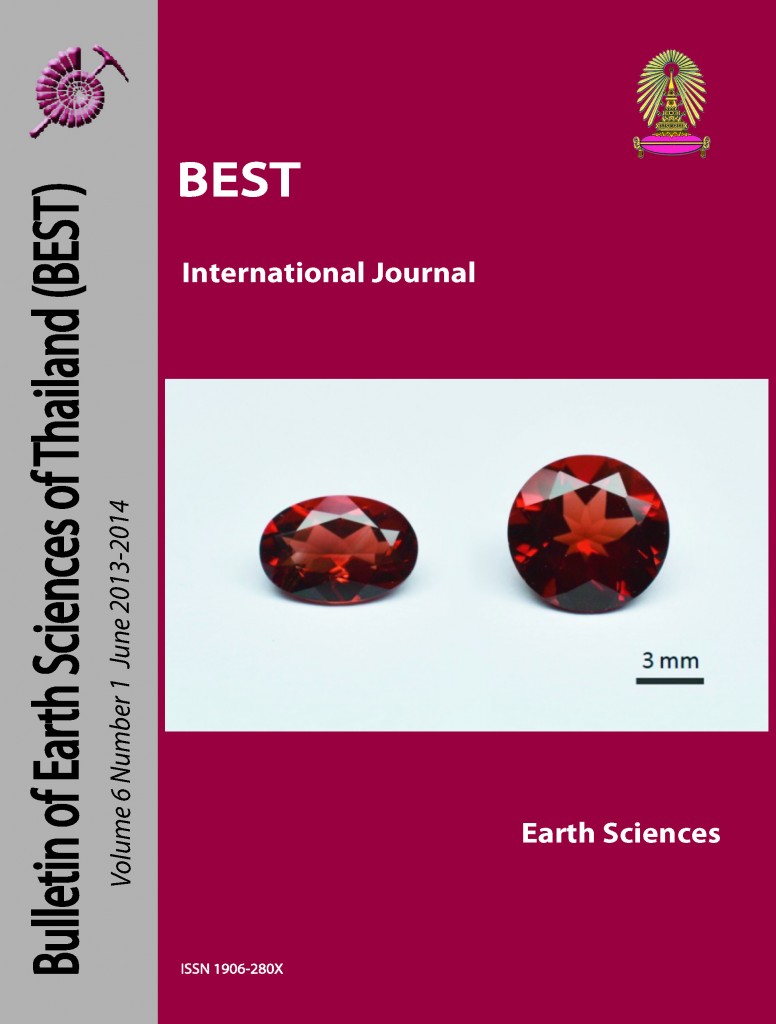Seismic Geomorphology in the Late Cenozoic Depositional Evolution of the Gulf of Thailand
Main Article Content
Abstract
Recent development of three-dimensional (3D) seismic datasets enables geologists to visualize and analyze buried land- and sea-scapes revealed by subsurface geophysical data in a manner resembling surface geomorphology. The seismic geomorphology is useful to interpret seismic
patterns for geomorphology of a formation, which is similar to using satellite and aerial photos of the Earth’s surface. A successful study of seismic geomorphology at the Gulf of Thailand situated within the Sunda shelf reveals the detailed information of paleoenvironment of the Pleistocene to Holocene time. Three sequence boundaries have been observed from the 3D seismic data. These sequence boundaries are related to a change in relative sea level during Pleistocene to Holocene time. The study area is dominated by delta, estuarine and present-day marine environments. The stacked point bar zone has formed in the study area that is potential a reservoir for shallow gas and/or biogenic gas. These results are expected to be a useful tool for petroleum exploration and development in the Gulf of Thailand and adjacent areas.
Article Details

This work is licensed under a Creative Commons Attribution-NonCommercial-NoDerivatives 4.0 International License.
Copyright © 2008 Department of Geology, Faculty of Science, Chulalongkorn University. Parts of an article can be photocopied or reproduced without prior written permission from the author(s), but due acknowledgments should be stated or cited accordingly.
References
Allen, G. P. and Posamentier, H. W., 1993. Sequence stratigraphy and facies model of an incised-valley fill: The Gironde estuary, France. J. Sediment. Petrol., 63, 378–391, doi: 10.1306/D4267B09-2B26- 11D7-8648000102C1865D.
Dalrymple, R. and Choi, K., 2006. Morphologic and facies trends through the fluvial-marine transition in tidedominated depositional system : A schematic framework for environmental and sequence-stratigraphic interpretation. Earth Sci. Rev., 81, 135-174, doi:10.1016/j.earscirev.2006.10.002.
Fyhn, M.B.W., Boldreel, L.O. and Nielsen, L.H., 2010. Escape tectonism in the Gulf of Thailand: Paleogene left-lateral pullapart rifting in the Vietnamese part of the Malay Basin. Tectonophysics, 483, 365–376, doi:10.1016/j.tecto.2009.11.004.
Hanebuth, T.J.J. and Stattegger, K., 2004. Depositional sequences on a late Pleistocene– Holocene tropical siliciclastic shelf (Sunda Shelf, Southeast Asia). J. Asian Earth Sci., 23, 113–126, doi:10.1016/S1367-9120(03)00100-7.
Hanebuth, T.J.J., Stattegger, K. and Bojanowski, A., 2009. Termination of the Last Glacial Maximum sea-level lowstand: the Sunda sea-level record revisited. In: Camoin, G., A. Droxler, K. Miller, and C. Fulthorpe, (Eds.), Records of Quaternary sea-level changes. Global Planet. Change, 66, 76–84, doi:10.1016/j.gloplacha.2008.03.011.
Hanebuth, T.J.J., Voris, H.K., Yokoyama, Y., Saito, Y. and Okuno, J.I., 2011. Formation and fate of sedimentary depocentres on Southeast Asia's Sunda Shelf over the past sea-level cycle and biogeographic implications. Earth Sci. Rev., 104, 92-110, doi:10.1016/j.earscirev.2010.09.006.
Jardine, E., 1997. Dual petroleum systems governing the prolific Pattani Basin, offshore Thailand. Petroleum systems of S.E. Asia and Australasia Conference, Jakarta, 351–363.
Lockhart, B.E., Chinoroje, O., Enomoto, C.B., and Hollomon, G.A., 1997. Early Tertiary deposition in the southern Pattani Trough, Gulf of Thailand. In: Proceedings of the International Conference on the Stratigraphy and Tectonic Evolution of Southeast Asia and the South Pacific. Department of Mineral Resources, Bangkok, 476–489.
Maynard, J., 2010. From bar to valleys: The sedimentology and seismic geomorphology of fluvial to estuarine incised valley fills of the Grand rapid formation (Lower Cretaceous), Iron river field. J. Sediment. Res., 80, p.611-638, doi: 10.2110/jsr.2010.060.
Miall, A.D., 2002. Architecture and sequence stratigraphy of Pleistocene fluvial systems in the Malay Basin, based on seismic time-slice analysis. Am. Assoc. Pet. Geol. Bull., 86 (7), 1201–1216, doi: 10.1306/61EEDC56-173E-11D7-8645000102C1865D.
Morley, C.K., and Westerway, R., 2006. Subsidence in the super-deep Pattani and Malay basins of Southeast Asia: a coupled model incorporating lowercrustal flow in response to post-rift sediment loading. Basin Res., 18, 51–84, doi: 10.1111/j.1365-2117.2006.00285.x.
Morley, C. K., Charusiri, P. and Watkinson, I., 2011. Structural geology of Thailand during the Cenozoic. Book series “The Geology of Thailand”, Geological Society of London, 273-334.
Posamentier, H.W., 2001. Lowstand alluvial bypass systems: Incised vs. unincised. Am. Assoc. Pet. Geol. Bull., 85 (10), 1771–1793, doi: 10.1306/8626D06D173B-11D7-8645000102C1865D.
Reijenstein, H., Posamentier, H.W. and Bhattacharya, J.N., 2011. Seismic geomorphology and high-resolution seismic stratigraphy of inner-shelf fluvial, estuarine, deltaic, and marine sequence, Gulf of Thailand. Am. Assoc. Pet. Geol. Bull., 95 (11), 1959-1990, doi: 10.1306/03151110134.
Wood, L.J., 2007. Quantitative Seismic Geomorphology of Pliocene and Miocene Fluvial System in the Northern Gulf of Mexico, U.S.A.. J. Sediment. Res., 77, 713-730, doi: 10.2110/jsr.2007.068.


